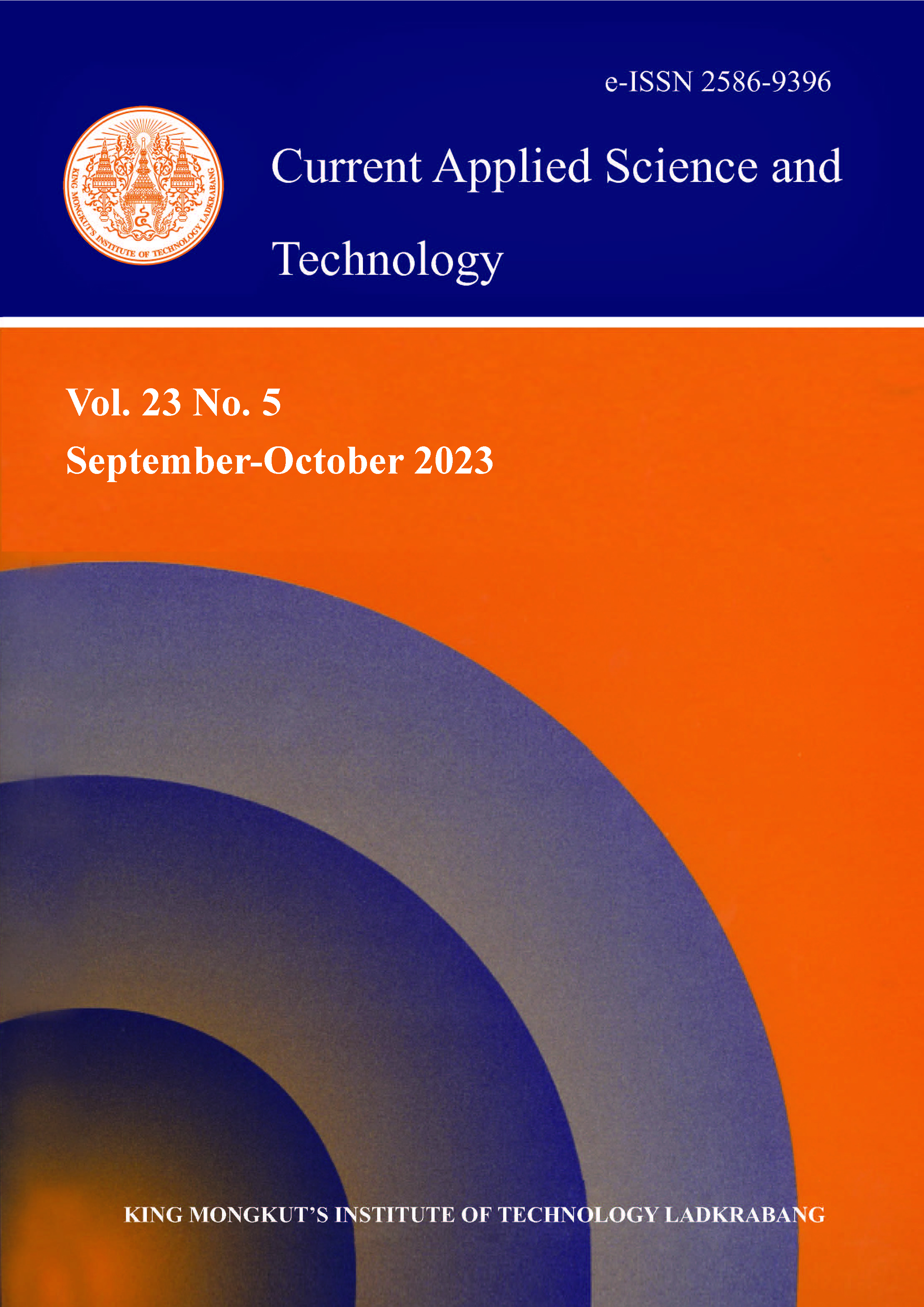A Novel Method Using Two-stage Anaerobic Digestion Integrated with Greenhouse Solar Dryer for Increased Biogas Production
Main Article Content
Abstract
Solar energy is infinite and environmental-friendly energy that is widely used in many fields such as solar cells, solar roofs, solar dryers and so on. However, solar energy has never been used in anaerobic digestion processes for biogas production. The use of solar energy may accelerate the biogas reaction to achieve higher gas production rates. Hence, the purpose of this research was to study a two-stage anaerobic digestion system in combination with a greenhouse solar dryer to increase the rate of biogas production. The study consisted of two parts: the first was to study the temperature variations in greenhouse solar dryers using computational fluid dynamic techniques, and the second was to conduct two-stage anaerobic digestion integrated with the greenhouse solar dryer system for biogas production. The results showed that the average temperature and biogas production rate in the integrated two-stage anaerobic digestion system compared to a conventional system increased by 16.2% and 19.69 %, respectively.
Keywords: anaerobic digestion; biogas; greenhouse solar dryer; solar energy
*Corresponding author: Tel.: (+66) 915166444
E-mail: thaithat.su@ksu.ac.th
Article Details

This work is licensed under a Creative Commons Attribution-NonCommercial-NoDerivatives 4.0 International License.
Copyright Transfer Statement
The copyright of this article is transferred to Current Applied Science and Technology journal with effect if and when the article is accepted for publication. The copyright transfer covers the exclusive right to reproduce and distribute the article, including reprints, translations, photographic reproductions, electronic form (offline, online) or any other reproductions of similar nature.
The author warrants that this contribution is original and that he/she has full power to make this grant. The author signs for and accepts responsibility for releasing this material on behalf of any and all co-authors.
Here is the link for download: Copyright transfer form.pdf
References
Demirel, B. and Yenigun, O., 2002. Two-phase anaerobic digestion processes: a review. Journal of Chemical Technology and Biotechnology, 77, 743-755.
Ahn, J.H. and Forster, C.F., 2002. The effect of temperature variations on the performance of mesophilic and thermophilic anaerobic filters treating a simulated papermill wastewater. Process Biochemistry, 37, 589-594.
Moestedt, J., Rönnberg, J. and Nordell, E., 2017. The effect of different mesophilic temperatures during anaerobic digestion of sludge on the overall performance of a WWTP in Sweden. Water Science and Technology, 76(12), 3213-3219.
Thai Meteorological Department, 2020. Thailand Annual Weather Summary. [online] Available at: https://www.tmd.go.th/climate/climate.php?FileID=5.
Janjai, S., 2012. A greenhouse type solar dryer for small-scale dried food industries: Development and dissemination. International Journal of Energy and Environment, 3(3), 383-398.
Iqbal, M., 1983. An Introduction to Solar Radiation. Toronto: Academic Press.
Kasten, F. and Young, T., 1989. Revised optical air mass tables and approximation formula. Applied Optics, 28, 4735-4738.
Thevenard, D. and Gueymard, C., 2010. Updating the ASHRAE climatic data for design and standards. ASHRAE Transactions, 116(2), 444-459.
Owen, M.S. and Kennedy, H.E., 2009. ASHRAE Handbook: Fundamentals. SI ed. Atlanta: American Society of Heating, Refrigerating and Air-conditioning Engineers, Inc.
Stephenson, D.G., 1965. Equations for solar heat gain through windows. Solar Energy, 9(2), 81-86.
Threlkeld, J.L., 1963. Solar irradiation of surfaces on clear days. ASHRAE Transactions, 69, 24-36.
Janjai, S., Intawee, P., Kaewkiew, J., Sritus, C. and Khamvongsa, V., 2011. A large-scale solar greenhouse dryer using polycarbonate cover: Modeling and testing in a tropical environment of Lao People’s Democratic Republic. Renewable Energy, 36, 1053-1062.
Srisowmeya, G., Chakravarthy, M. and Devi, G.N., 2019. Critical considerations in two-stage anaerobic digestion of food waste – A review. Renewable and Sustainable Energy Reviews, 119, DOI: 10.1016/j.rser.2019.109587.
Van, D.P., Fujiwara, T., Tho, B.L., Toan, P.P.S. and Minh, G.H., 2019. A review of anaerobic digestion systems for biodegradable waste: Configurations, operating parameters, and current trends. Environmental Engineering Research, 25(1), 1-17.
Ghaly, A. and Ben-Hassan, R., 1989. Continuous production of biogas from dairy manure using an innovative no-mix reactor. Applied Biochemistry and Biotechnology, 20, 541-559.
Paudel, S., Kang, Y., Yoo, Y.S. and Seo, G.T., 2017. Effect of volumetric organic loading rate (OLR) on H2 and CH4 production by two-stage anaerobic co-digestion of food waste and brown water. Waste Management, 61, 484-493.
Pavan, P., Battistoni, P., Cecchi, F. and Mata-Alvarez, J., 2000. Two-phase anaerobic digestion of source sorted OFMSW (organic fraction of municipal solid waste): performance and kinetic study. Water Science and Technology, 41, 111-118.
Chu, C.F., Li, Y.Y., Xu, K.Q., Ebie, Y., Inamori, Y. and Kong, H.N., 2008. A pH- and temperature-phased two-stage process for hydrogen and methane production from food waste. International Journal of Hydrogen Energy, 33, 4739-4746.
Salsali, H., Parker, W. and Sattar, S., 2005. Influence of staged operation of mesophilic anaerobic digestion on microbial reduction. Proceedings of the Water Environment Federation, 11, 4571-4586.






